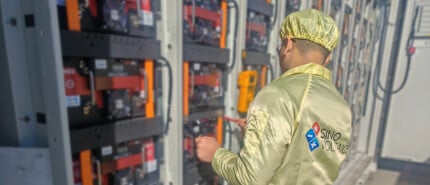Solar thermophotovoltaics (STPV) is not a new idea. It has been researched before and dumped.
Now Danish scientists are trying to breathe a new life into it. With certain advancements in technology, they are predicting a COMEBACK.
What is Solar thermophotovoltaics (STPV) ?
Simply said, thermophotovoltaics means getting electricity from heat waves.
Difference conventional photovoltaics and thermophotovoltaics
Normal photovoltaic cells respond only to the visible part of sunshine which is in the shorter wavelengths of the solar spectrum. That is because of the band gap of the materials used currently, namely silicon, Cd Te, etc.
Thermal radiation has longer wavelengths, which means the photons have a lower energy than photons of visible light. Different photocells with lower band gap energy are needed to convert those photons to electricity.
In an attempt to convert more of the solar spectrum multi-junction cells are also under investigation, where different junctions using different materials corresponding to different wavelengths together convert a broader spectrum of the incoming energy.
Current downside of multi-junction solar cells can be simply summarized: they’re expensive to make..
Solar energy: Thermal and visible
Conventional photovoltaics converts the visible part of solar energy to electricity. The visible part contains less than half of the solar irradiation, most of the rest being in the IR band (heat).
Thermophotovoltaics is the process of converting infrared (heat) radiation from hot bodies into electricity. It combines a heat engine with an electric generator.
Does it sound like a gas fired power generator? Indeed!
Software modeling has indicated the possibility that high temperature thermophotovoltaics could possibly compete with efficiency obtainable from combined cycle gas turbines generations.
How does thermophotovoltaics (STPV) work ?
The idea is very simple..
Simply convert all solar energy to heat, and let that heat radiate (at constant temperature) to a thermal photovoltaic detector that will convert it to electricity.
Concentrated solar power can be used to melt silicon. The change of state from solid to liquid absorbs a large amount of energy. The liquid is stored in insulated containers.
When required, the molten silicon is allowed to cool down by radiation and the radiated energy is converted to electricity by a process similar to photovoltaic conversion. But the photons involved are at lower energy, and photodiodes other than silicon with a much smaller band gap have to be used as converters.
Research is on for developing efficient photodiodes for with very small band gaps.
Multi-junction systems will not be needed. Balance of the system is the same as for the conventional PV. This system is comparable to a carnot heat engine (more details here), and hence, the efficiency is much better if the radiator radiates at high temperature and the photocell is at a low temperature.
Cost and scalability
STPV can cost an order of magnitude less than combined cycle gas (CCG) power generation. Storage can be possible on a grid scale.
When talking of grid scale..
responding to short and sudden changes in power demand is a headache for the supply companies. Cheap generation demands a large scale. Large scale generators do not like quick switch on and switch off and cannot economically follow changes in demand.
Advantages of STPV
How fast can an elephant rise or sit down compared to a puppy?
STPV can respond almost instantly to meet changes in demand. No other source of power can respond that fast. STPV employs almost no moving parts. This enhances reliability and reduces maintenance costs.
STPV applications
STPV can be very useful in remote unattended power stations operating alone or grid connected.
In the battlefield, they have the advantage of quiet operation, unlike a generator which broadcasts itself. Man pack STPV generators are also a serious possibility. Space travel is another field of application.
STPV progress made in 2016
Solar thermophotovoltaics (STPV) just got a shot in the arm..
Danish scientists from the Aalborg University in Denmark have described new high temperature material which can absorb the entire spectrum of solar energy much more efficiently. This will help improve the conversion efficiency levels achievable via solar thermophotovoltaics.
The new absorbers were able to operate at 800° C or 1073 K, and absorb energy from 300 to 1750 nm. This covers from ultraviolet (UV) to near Infrared (NIR), spanning a major portion of the solar spectrum.
The absorption was achieved by using a metal-insulator-metal (MIM) resonator. MIM resonators are not new, but the materials they used are different. They used alumina insulator sandwiched between a thin layer, and a thick layer of tungsten metal. Previous resonators used metals like gold and chromium which could not withstand temperatures beyond 500°C or 773K.
Expect to hear more about Thermophotovoltaics!







Emeka Umeh.
on 29 Dec 2017Dricus
on 07 Jan 2018Kevin Buckley
on 18 Nov 2016